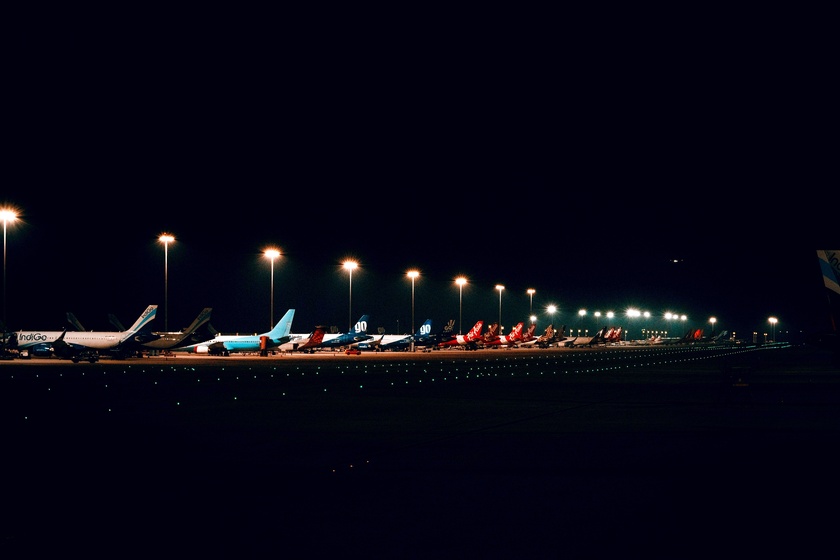Three weeks ago in our article ‘Aviation, Please Understand Fed’s Actions. Your Livelihood Depends On It!’ we stated we asked the following question:
If you pay the least bit of attention to the economy and what’s going on in the country from an economic perspective, you would’ve undoubtedly noticed that everyone in the finance and economic space seems to wait with bated breath on what the Federal Reserve (Fed) chairman – currently Jerome Powell – has to say when he gives a public address. Ever wonder why the words of the present chairperson of the Federal Reserve are so important?
It would seem that there are some groups that put more importance on the information that comes out of the Federal Reserve (Fed) than others. It would seem as if academic and stock market traders care more about what’s going on with the Fed and what the Fed says than actual businesses in the real economy. It also seems like an entire ecosystem is built around the information that comes from the Fed.
On Aviation™ Note: The Federal Reserve has a dual mandate: full employment – based on how they calculate full employment which does not actually mean that everyone is employed, and price stability.
Notwithstanding the fact that many believe that the Federal Reserve is failing at its mandates, the information it presents seems very important to some groups and not so much to others. We purport that the information the Federal Reserve puts out should be important to us but not to the point where we are constantly focusing on that information and making our entire business activities geared towards it. That information is important because the policies of the Federal Reserve affect us particularly as it relates to money supply – which includes The availability of credit – And a stable monetary base for us to do business and personal transactions.
However, the most important thing for us to understand about Fed action is inflation. Inflation affects everyone in the economy, but more so those who do not have the kind of assets that can protect somewhat against inflation. This is why for us in aviation a thorough understanding of inflation is always important. Therefore, understanding the Federal Reserve's actions and why it does what it does is very important.
On Aviation™ Note: as a reminder: Inflation is an increase in the money supply within an economy, without a commensurate increase in the amount of goods and services relative to the increase in the money supply.
In this week’s On Aviation™ full article, we share some very important insights into why the announcements and information from the Federal Reserve are so important, and why it is more important to some groups than others.
For related readings, please see also:‘The Aviation Industry and Economic Uncertainties’, ‘High Interest Rates/Cost of Borrowing and Their Effects on Aviation Businesses’,’Debt: Its effects on the Aviation Industry’, ‘Economic Crisis and the Aviation Industry’, ‘The Aviation Industry Must Not Mistake A Recession’, ‘Understanding Recessions’, ‘Money and Recessions.’, ‘Recession: Should we still be concerned?’, ‘Stagflation: Should the Aviation Industry be Concerned?’ ‘Aviation: Are We In BIG Trouble?’, ‘Aviation: Recession Red Flags?’, ‘Aviation, Pay Attention To The ‘Canary In The Coal Mine’’, ‘The Canaries 'Banks’ Are Dying.’, ‘Aviation; Should We Be Concerned About The Fed’s Actions?’, ‘Private Sector Recession: Should Aviation be Concerned?’, ‘Dying Business Travel: The Airlines Achilles Heel?’’, and ‘Aviation, Please Understand Fed’s Actions. Your Livelihood Depends On It!’
For some reason, the Fed continues to publish the Summary of Economic Projections (SEP), in which Federal Open Market Committee (FOMC) members guess the trajectory of macroeconomic indicators like gross domestic product, the unemployment rate, and price inflation. They also take a stab at forecasting their own policy decisions over the next few years in what is known as the “dot plot” (figure 1).
Figure 1: FOMC participants’ assessments of appropriate monetary policy: Midpoint of target range or target level for the federal funds rate

One issue with these projections is that they are usually very wrong. You would expect the FOMC members’ projections for their own policy rate to be the most accurate, since they have complete control over it. I’ve compiled their projections and the actual course of the federal funds rate (FFR) in the graph below.
Figure 2: Federal funds rate, actual (black) and quarterly projections, 2015–22

This graph might be a little difficult to take in, so let me explain it. The black line shows the actual FFR at the end of each year. The dashed lines show the median projection for the FFR in each of the quarterly meetings. The projections and the actual values are lined up in time, so in each year you can see how close (or how far off) the FOMC members were in their guesses. We should expect the beginning of each blue dashed line to touch the black line or at least be very close to it because the blue dashed line represents a December projection for the end of the year FFR, which by that point is about two weeks away.
The notable feature of this graph is that the FOMC was caught off guard by the pandemic and by recent price inflation. But notwithstanding the size of those surprises, the graph shows that the prepandemic guesses were no good either. For example, the December 2015 projection was off by roughly 100 basis points for the years 2016–18.
Forward Guidance
The Fed’s rationale for publishing these forecasts is to provide “forward guidance”—the Fed’s way of not surprising financial markets. The problem with forward guidance is that to the extent that market participants rely on the FOMC projections, the projections themselves become an element of surprise. Financial markets get spooked if the projections are revised unexpectedly from one meeting to the next, in the same way that they would react to a plain adjustment of the target range for the FFR. This was evident after the most recent FOMC meeting: the stable target rate was expected, but the revised projections were not.
One of the journalists at the most recent FOMC press conference brought up the usefulness of these projections. After noting some of the abrupt changes in the forecasts, Michael McKee of Bloomberg asked, “How much confidence do you have, can investors have, or the American people have in your forecasts?”
“Well,” Powell recited, “forecasts are highly uncertain. Forecasting is very difficult. Forecasters are a humble lot with much to be humble about.”
In 2016, the Brookings Institution surveyed academics and “private-sector Fed watchers” on their view of Fed projections. Only a third of respondents considered the SEP’s dot plots as “useful” or “extremely useful.” About half of the respondents evaluated the SEP overall as useful.
The view of the Fed from an ivory tower seems to be much nicer than the view from a trading floor or business office:
There was strong disagreement about whether Fed communications helps the real economy and/or the financial markets: 35% said it helps both the markets and the economy while 42% said it helps neither. The divide fell sharply on academic/private-sector lines: 55% of academics thought Fed communications was good for both the real economy and markets while only 21% of private-sector Fed watchers thought so. About half (52%) of private-sector Fed watchers thought it helped neither.
Strikingly, academics thought the Fed’s current approach to communications was far more helpful to the markets than those in the markets said. Some 73 percent of academics said Fed communications helps the markets; only 44 percent of private-sector Fed watchers agreed.
“Fed Watching” as a Sport
Despite what these survey results imply, it seems like the entire financial sector is enthralled by FOMC meetings when they occur. All eyes are on the Fed chair as he simply reads the transcript of an announcement that has already been posted online. Financial news media post moment-by-moment commentary on minutiae like small textual changes from one announcement to the next and the tone of Powell’s voice.
Fed watching has become a veritable sport, with cheerleaders, teams (bulls versus bears), live commentary, and an unhealthy amount of gambling. And unlike the NFL, the Fed has grown more popular in the past few years.

But Fed watching isn’t just a game. There are real stakes and broad repercussions for correctly guessing whether Jay Powell will see his shadow when he emerges from the FOMC den on announcement days.
Discussing how the Fed has become a “Big Player” in financial markets, Roger Koppl noted that there has been a “reallocation of resources toward ‘Fed watching’” due to the potential rewards for guessing the Fed’s next move.
So, the costs of a gargantuan central bank are even bigger than the inflation and business cycles they generate.
Every Econ 101 student learns that we incur opportunity costs when we use scarce resources. One of those scarce resources is our own attention. The nature of the Fed’s rigged game encourages entrepreneurs to pay attention to how much Jay Powell’s brow glistens when he announces a quarter-percentage-point revision to core Personal Consumption Expenditures Price Index inflation projections.
And this attention comes at the expense of what entrepreneurs would be focused on—namely, satisfying consumers—if there weren’t a big money-printing circus coming into town on a regular basis.
Unfortunately, the Fed has much influence on retirement savings, mortgage rates, the cost of living, stock market ups and downs, production, consumption, and international trade. Can we afford to ignore it?
_________________
Author:
Dr. Jonathan Newman is a Fellow at the Mises Institute. He earned his PhD at Auburn University while a Research Fellow at the Mises Institute. He was the recipient of the 2021 Gary G. Schlarbaum Award to a Promising Young Scholar for Excellence in Research and Teaching. Previously, he was Associate Professor of Economics and Finance at Bryan College. He has published in the Quarterly Journal of Austrian Economics and in volumes edited by Matthew McCaffrey and Per Bylund. His research focuses on Austrian economics, inflation and business cycles, and the history of economic thought. He has taught courses on Macroeconomics and Quantitative Economics: Uses and Limitations in the Mises Graduate School. He is the author of two children's books: The Broken Window and Ludwig the Builder. His commentary appears regularly in the Mises Wire and Power & Market.
_____________________
This article was published in the Mises Wire on October 03, 2023, with the title “Fed Forecasts: Financial Sport or Costly Distraction?”. The views expressed are the author’s and do not constitute an endorsement by or necessarily represent the views of On Aviation™ or its affiliates.
Thank you for reading this week's On Aviation™ full article. In what ways are you concerned about the information coming out of the Federal Reserve? Please share your thoughts in the comments below. Remember to check out our On Aviation™ Podcast and continue the conversation on our Twitter and Instagram.
Orlando - On Aviation™


















